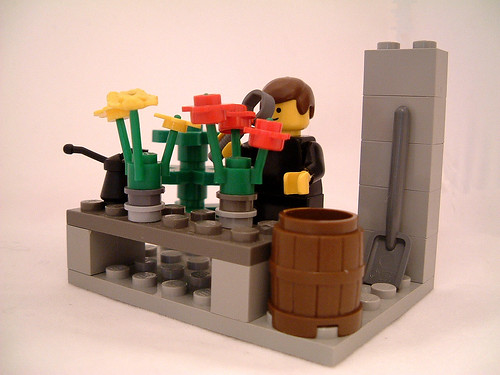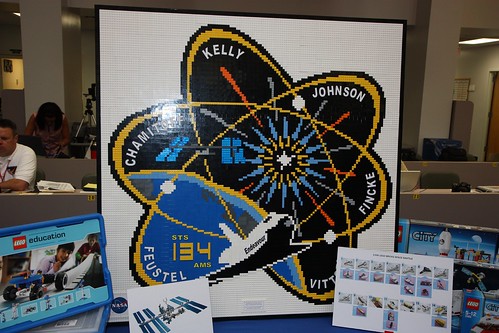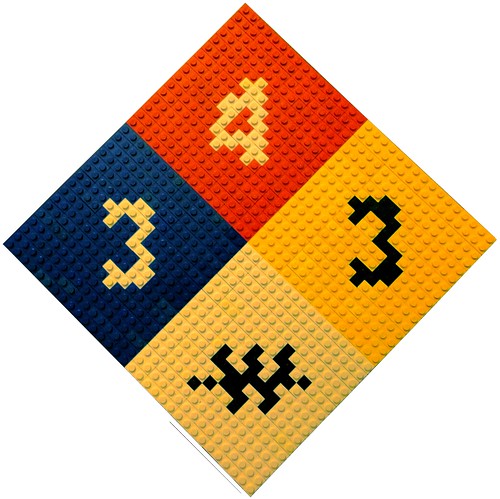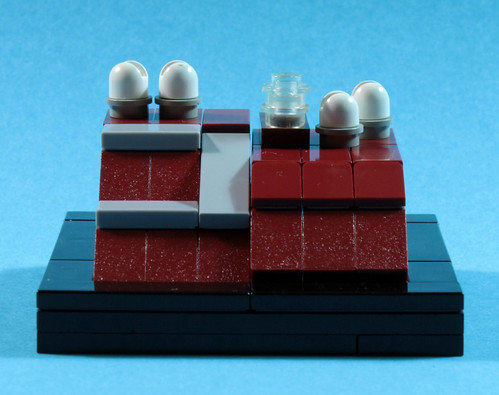
Sunday, July 31, 2011
Friday, July 29, 2011
Shuttle set rerelease
As part of a tribute to the end of the Space Shuttle program, LEGO is rereleasing set 10231, Shuttle Expedition. This is a fairly minor reworking of last year's set 10213, Shuttle Adventure. It's supposed to be a more sturdy design to be more play-able for younger kids.




Tuesday, July 26, 2011
Curiosity
Just because the Space Shuttle program is over doesn't mean NASA is shutting down. Our astronauts will continue to visit the International Space Station using other rockets, and a future manned program is in the works. More immediately, though, is the Curiosity (here built by Tim Goddard), an unmanned probe that will launch for Mars later this year. The Mars Space Laboratory's mission is to collect and analyze samples to see if Mars can, or has in the past, support any form of life.


Sunday, July 24, 2011
Doppler effect
Since sound travels as a wave, if you move the source of that sound, the waves will be pushed closer together (higher tone) or further apart (lower tone). This is the source of the doppler effect, as you can hear when a firetruck goes past, or in this rotating speaker by ISOGAWAYoshihito. This is also the source of the red shift that indicates that other galaxies are moving away from us.
Thursday, July 21, 2011
Welcome home, Atlantis
With the landing of the Atlantis, three decades of the Space Shuttle program draws to a close. It feels like I've been watching these things go up in the air for most of my life, so it's kind of a sad moment. Whither now, NASA? Remember when George Bush announced the next step for NASA was a trip to Mars? The NASA Authorization Act of 2010 provides for development of a new launch system, to ultimately move beyond Earth orbit in five years, but in the meantime our Astronauts will be riding Russian rockets up to the ISS, or else fly on commercial carriers. This Shuttle sculpture is from Legoland Windsor.


Wednesday, July 20, 2011
Happy birthday, Gregor
As anyone who visits Google knows, today is the 189th anniversary of the birth of Gregor Mendel (here in LEGO form by Kaptain Kobold). Mendel discovered the basic laws of genetics while observing the growth of pea plants. He noted that if two plants with purple flowers are crossed, the offspring has purple flowers. If two with white flowers are crossed, the offspring has white flowers. However, if a purple flowered plant is crossed with a white flowered plant, the offspring has purple flowers. While the molecular basis for this would not be discovered for fifty years, he correctly surmised that flower color is driven by a pair of factors, and there are dominant and recessive genes. He worked out the implications of how genes are mixed and matched in sexual reproduction, and is considered the father of genetics.

Just a quick apology for the month long hiatus in this blog. Life has been hectic lately.

Just a quick apology for the month long hiatus in this blog. Life has been hectic lately.
Saturday, June 18, 2011
Shinkai 6500
I previously noted the Japan-exclusive set 21100, Shinkai 6500. Builder Ocean-Storm made a number of modifications to make a more accurate model of the deep-sea explorer.


Thursday, June 16, 2011
Building in space
The other day I mentioned the LEGO sets sent to the International Space Station. While some of them are more fun, like a model of the ISS, some of them will be physics experiments. LEGO hasn't posted lesson plans yet, but students here on earth will build models to do simple experiments, like compare mass using a balance, and their results will compare to those performed in orbit, under conditions of microgravity.


Tuesday, June 14, 2011
STS-134
STS-134, which landed recently, was the next to last Space Shuttle mission. One fun aspect of this mission was the launch (literally) of a partnership between LEGO and NASA. A set of LEGO models was brought up on the Shuttle to the International Space Station as part of an interactive project to get grade school kids excited about science. This actually isn't the first such partnership, but more on that at another time.


Sunday, June 12, 2011
Friday, June 10, 2011
Wednesday, June 8, 2011
MRI
MRI, or Magnetic Resonance Imaging, is based on the same principles as NMR (Nuclear Magnetic Resonance) (they changed the name out of concern that patients wouldn't come near something 'nuclear'). Hydrogen atoms have a very small magnetic moment. Normally, these magnetic moments are completely random and cancel out. When placed in a strong external magnetic field, these hydrogen nuclei align either with or against the external field. When these are pulsed with radio wave energy, the tiny atomic magnetic moments flip from low energy state, to high energy state, and then relax back to the low energy state. Since the body is full of water molecules, mapping out the location and density of these molecules (or, more properly, the hydrogen atoms in the H2O), doctors can get a peek inside your skin.


Saturday, May 21, 2011
NFPA 704
If you've spent any time around a chemical laboratory, you're familiar with these colorful diamonds. Even if you haven't, you've probably seen them where ever potentially dangerous chemicals are stored. The National Fire Protection Association designed the chemical hazard label (here by me) to be a quick indicator of the presence of dangerous substances.

This symbol is found on individual chemical containers, and also on the doors to rooms containing these chemicals. The blue box indicates health hazards ranging from 0 (no hazard, no precautions needed) to 4 (potential to cause serious harm or death upon short exposure). The red box is for flammability, from 0 (inflammable) to 4 (forms an extremely flammable vapor at normal pressure and temperature). The yellow box notes reactivity, again ranging from 0 (completely stable) to 4 (capable of detonation or explosive decomposition). The white box is reserved for special hazards. The NFPA standard only recognizes OX for oxidizing agents, and a W with a slash for those substances that react with water. Informally, people often add other hazards to this box, such as the symbol for radioactivity, or the word ACID, etc. One thing to note, you have to include the highest level hazard on the sign, so if you saw the NFPA label below on the door to my lab, it tells you that there is at least one substance in the room with a health hazard of 3, another substance that has the flammability of 4, perhaps still another with a reactivity of 3, and something else that reacts with water, not necessarily any one chemical with all of those properties. The idea is that someone entering the room (particularly an emergency responder) would know what possible hazards are there and what protective gear they need to wear.

This symbol is found on individual chemical containers, and also on the doors to rooms containing these chemicals. The blue box indicates health hazards ranging from 0 (no hazard, no precautions needed) to 4 (potential to cause serious harm or death upon short exposure). The red box is for flammability, from 0 (inflammable) to 4 (forms an extremely flammable vapor at normal pressure and temperature). The yellow box notes reactivity, again ranging from 0 (completely stable) to 4 (capable of detonation or explosive decomposition). The white box is reserved for special hazards. The NFPA standard only recognizes OX for oxidizing agents, and a W with a slash for those substances that react with water. Informally, people often add other hazards to this box, such as the symbol for radioactivity, or the word ACID, etc. One thing to note, you have to include the highest level hazard on the sign, so if you saw the NFPA label below on the door to my lab, it tells you that there is at least one substance in the room with a health hazard of 3, another substance that has the flammability of 4, perhaps still another with a reactivity of 3, and something else that reacts with water, not necessarily any one chemical with all of those properties. The idea is that someone entering the room (particularly an emergency responder) would know what possible hazards are there and what protective gear they need to wear.
Thursday, May 19, 2011
Haleakala Observatories
MorsLEGO made a tiny model of the Haleakala Observatories on Maui. The location (altitude, weather and lack of light pollution) makes this an ideal site. These observatories contain several telescopes and other instruments devoted to a wide variety of missions, such as tracking the movements of the earth's tectonic plates by bouncing a laser off the moon, tracking asteroids, a military project to track enemy satellites, and a telescope devoted to educational projects that teachers can apply to participate in.


Tuesday, May 17, 2011
Shinkai 6500
No other manned research submarine can dive deeper than the Shinkai 6500, a vessel operated by JAMSTEC, the Japan Agency for Marine-Earth Science and Technology. This year, LEGO offered set 21100 based on this sub exclusively in Japan. Ocean-Storm shows the Shinkai 6500 here investigating a hydrothermal vent. Superheated water issues from these cracks in volcanically active areas, often including high levels of sulfur. The energy and minerals available from these vents can give rise to very unique life forms, such as the giant tube worms seen here.


Thursday, May 12, 2011
Breaking Bad
Chemistry is the study of change. Electrons change their energy levels, Molecules change their bonds, elements combine and change into compounds. It is all of life: the constant, the cycle. Solution, dissolution, over and over and over. Growth, then decay, then transformation. It is fascinating. Really.
That's what Walter White tells his students in the pilot of Breaking Bad. When his life begins to fall apart, he starts synthesizing metamphetamine. The chemistry there is actually pretty simple (let's face it, there are a lot of people making meth out there who ain't the sharpest knives in the place where they keep the knives), but I don't know if I feel comfortable going into it here. Instead let's get into something much more kid-friendly: how to make poison gas. ;) When confronted by two other drug dealers who want to kill Walter and his partner Jesse, he throws some chemicals together and suddenly the bad guys (the badder guys?) are choking on the floor. He tells Jesse "red phosphorus in the presence of moisture and accelerated by heat yields phosphorus hydride, phosphine gas." Actually, not quite, according to Dr. Jonathan Hare. He probably should have used white phosphorus, a different allotrope of phosphorus. Allotropes are different ways of arranging atoms of just one element. For instance, both graphite and diamond are allotropes of carbon. White phosphorus consists of four atoms arranged at the points of a tetrahedron. When this is heated over 250 degrees Celsius, it transforms into red phosphorus, which is an amorphous network of phosphorus atoms. You probably know red phosphorus best from wooden matches. Anyway, when white phosphorus is heated with water at basic pH, phosphine gas is indeed produced.
P4 + 3 NaOH + 3 H2O ? 3N aH2PO2 + PH3

Orion Pax made this awesome rendition of Walter's RV
That's what Walter White tells his students in the pilot of Breaking Bad. When his life begins to fall apart, he starts synthesizing metamphetamine. The chemistry there is actually pretty simple (let's face it, there are a lot of people making meth out there who ain't the sharpest knives in the place where they keep the knives), but I don't know if I feel comfortable going into it here. Instead let's get into something much more kid-friendly: how to make poison gas. ;) When confronted by two other drug dealers who want to kill Walter and his partner Jesse, he throws some chemicals together and suddenly the bad guys (the badder guys?) are choking on the floor. He tells Jesse "red phosphorus in the presence of moisture and accelerated by heat yields phosphorus hydride, phosphine gas." Actually, not quite, according to Dr. Jonathan Hare. He probably should have used white phosphorus, a different allotrope of phosphorus. Allotropes are different ways of arranging atoms of just one element. For instance, both graphite and diamond are allotropes of carbon. White phosphorus consists of four atoms arranged at the points of a tetrahedron. When this is heated over 250 degrees Celsius, it transforms into red phosphorus, which is an amorphous network of phosphorus atoms. You probably know red phosphorus best from wooden matches. Anyway, when white phosphorus is heated with water at basic pH, phosphine gas is indeed produced.
P4 + 3 NaOH + 3 H2O ? 3N aH2PO2 + PH3

Orion Pax made this awesome rendition of Walter's RV
Tuesday, May 10, 2011
Saturn V
Matt Wagner rendered this great version of the Saturn V, the rocket that sent the Apollo missions to the moon, based on set 7468, Saturn Moon Mission.


Sunday, May 8, 2011
Arecibo message
On November 16, 1974, a 1679 digit message was broadcast into space from the Arecibo Telescope. The stream of 0's and 1's was created by shifting the frequencies, or, here in LEGO form by Chris Doyle.

1679 is the product of 23 x 73. If some alien race receives the signal, and then breaks it down into 79 separate sets of 23, then can then assemble these into a picture.

The result would give them information about us - an indication of the elements used in our DNA makeup, an image of the double helix, an image of a human, and the composition of our Solar System.

This was really more of a proof of concept experiment than an actual attempt at communication with others in our universe. Given that the globular star cluster targeted by this message is 25000 light years away, any response would come in about the year 52000 AD.
BTW, Carl Sagan, who was a proponent of the search for extra-terrestrial intelligence (SETI), was a part of the composition of the message. If you read Contact (again, please, don't watch the horrible movie), he spends a great deal of time discussing how messages could be transmitted across the stars and subsequently decoded.

1679 is the product of 23 x 73. If some alien race receives the signal, and then breaks it down into 79 separate sets of 23, then can then assemble these into a picture.

The result would give them information about us - an indication of the elements used in our DNA makeup, an image of the double helix, an image of a human, and the composition of our Solar System.

This was really more of a proof of concept experiment than an actual attempt at communication with others in our universe. Given that the globular star cluster targeted by this message is 25000 light years away, any response would come in about the year 52000 AD.
BTW, Carl Sagan, who was a proponent of the search for extra-terrestrial intelligence (SETI), was a part of the composition of the message. If you read Contact (again, please, don't watch the horrible movie), he spends a great deal of time discussing how messages could be transmitted across the stars and subsequently decoded.
Thursday, May 5, 2011
Freedom 7
Fifty years ago today, Alan Shepard became the first American (and the second person, after Yuri Gargarin) to enter space. The Mercury program was the first step (followed by the Gemini and Apollo programs) towards the moon landing. Those 16 minutes of going up and coming back down again are commemorated in this model by Dave and John Xandegar of briXwerX Studio.


Tuesday, May 3, 2011
Very Large Array
The Very Large Array is a multiple aperture radio telescope. That is, it is made up of 27 separate dishes that can be configured over a 22 mile radius to act as one huge radio telescope. Special carriers on railroad tracks allow the dishes to be arranged into different configurations. The VLA has been used to study such phenomena as ice on the surface of Mercury and cosmic jets of material expelled from distant galaxies. It's also showed up in popular culture, as in the final scenes of Contact. BTW, that's a really horrible movie, but the book is outstanding. If you read the book you learn about graduate school in the sciences, how research funding works, how radio antennae study distant galaxies, how we can encode and decode messages and international relations in the sciences. If you watch the movie you get to see Jodie Foster and Matthew McConaughey hook up.

BTW, David Wegmuller even built a wprking mechanism to move his VLA dish, above. Now he just needs to build 26 more of these and spread them out over a gymnasium floor.

BTW, David Wegmuller even built a wprking mechanism to move his VLA dish, above. Now he just needs to build 26 more of these and spread them out over a gymnasium floor.
Subscribe to:
Posts (Atom)

